




Optical Isomerism - A Brief Description
Optical isomers refer to those stereoisomers that have the same molecular formula and even exhibit identical physical and chemical properties. However, they have a different spatial arrangement, and because of this, they react differently to the plane-polarised light. They are non-superimposable mirror images of each other and are found in molecules having asymmetric carbon.
One of the isomers rotates the plane-polarised light when passed through its solution in the clockwise direction. It is referred to as (+) or D-isomer (dextrorotatory). On the other hand, the other one rotates the plane-polarised light when passed through its solution in the anti-clockwise direction and is referred to as (-) or L-isomer (laevorotatory). These are the two types of optical isomerism. We will discuss optical isomerism examples for compounds without chiral centres.
Compounds with No Chiral Carbon
It is widely known that to exhibit optical isomerism, the chemical compound must have a chiral carbon. However, there are a fair number of compounds that do not have chiral carbon yet exhibit optical activity. This is because these compounds are non-planar and give rise to non-superimposable mirror images. To find the chirality of these compounds, we look for symmetry elements that are the centre of symmetry and plane of symmetry.
A plane of symmetry is an imaginary plane that bisects the molecule in such a way that it gives identical mirror images.
The centre of symmetry is an imaginary point at the centre of a molecule (can be on an atom, on a bond, or in space) from where if we move equidistantly in the opposite directions, it will lead us to the same atoms or groups.
If any of these symmetry elements are present, the molecule will be optically inactive. Three of the molecules that bear no chiral carbon but are optically active molecules are allenes, spiro compounds, and biphenyls are discussed below.
Optical Isomerism in Allene
A consecutive diene or a cumulated diene is known as an allene. The 3 carbon atoms in allene are doubly bonded, so the central carbon atom is sp hybridised while the 2 carbon atoms on either side are sp2 hybridised. In 3-D, as the p-orbitals are at right angles, the overlapping of perpendicular p-orbitals results in one double bond being vertical while the other is horizontal. Therefore, the carbon with a horizontal double bond is attached to 2 groups vertically, while the vertically double bonded carbon is attached to 2 groups horizontally.
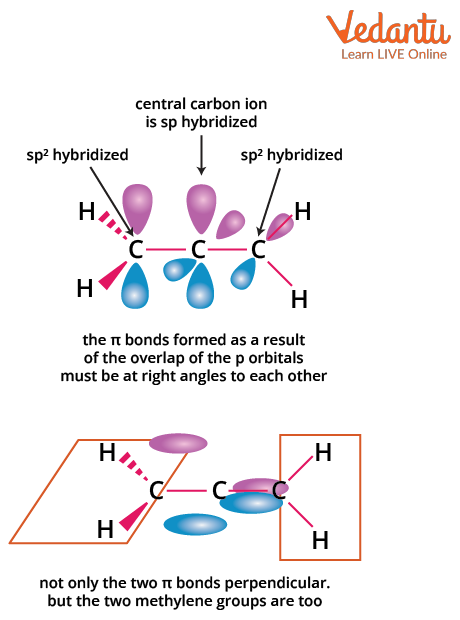
Orbital overlapping in Allene
For allenes to exhibit optical isomerism, the 2 groups attached to sp2 hybridised carbon must not be the same. However, they may or may not be identical to the groups attached to the other sp2 hybridised carbon as shown below.
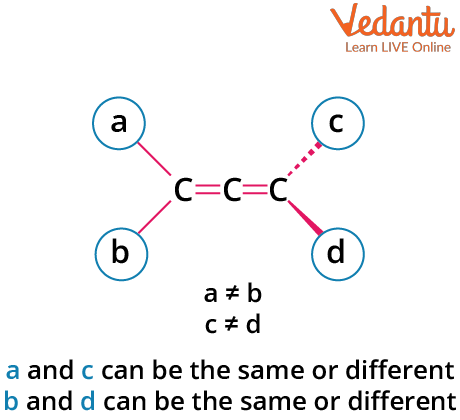
Side groups in allene that show optical activity
This way, no plane of symmetry or centre of symmetry will exist and will make them optically active. One example of optical isomerism in an allene is shown below.
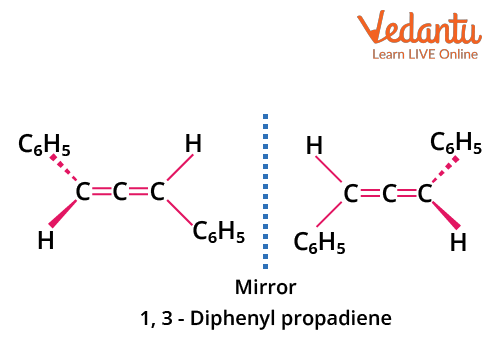
Optical isomers of 1,3-diphenyl propadiene
Optical Isomerism in Spiro Compounds
Spiro compounds are made up of two rings attached to a single carbon atom (spiro carbon atom), which is sp3 hybridised. This results in a tetrahedral geometry which makes the 2 rings perpendicular to each other (non-planar in 3-D). Spiro compounds thus give non-superimposable mirror images. The 3-D structure of the spiro compound can be equated with the structure of allene. Thereafter, similar conditions for the compound to show its optical activity are applied.
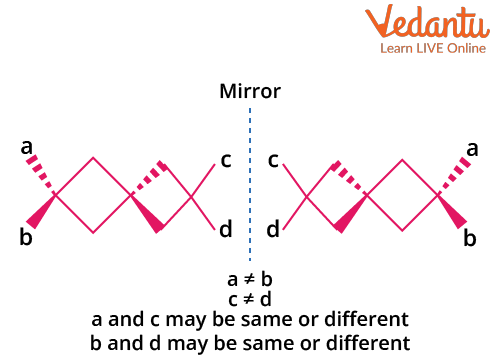
Optical isomerism in spiro compounds
The ring systems on either side of the central carbon atom may or may not be identical, but they would still be optically active.
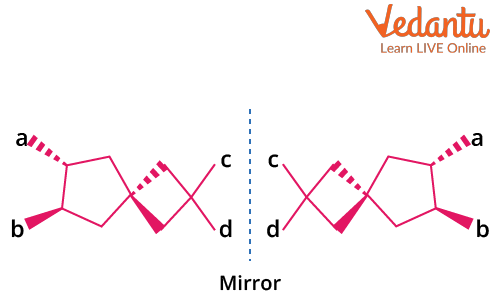
Optical isomerism in unsymmetrical spiro compound
Optical Isomerism in Biphenyl
Biphenyls are formed by 2 benzene rings attached via a single sigma bond. When biphenyl rings are substituted over ortho position, the carbon atoms in benzene are sp2 hybridised, thus the rotation across the sigma bond is restricted. Also, to minimise steric hindrances, both the rings lie perpendicular to each other. Substitution over meta or para positions allows the rings to move across the single sigma bond, causing it to become planar and create a plane of symmetry, rendering it optically inactive.
Optical activity in biphenyls is observed when ortho substitution is present over both the rings and the groups are not identical. Otherwise, a plane of symmetry will exist and it will become optically inactive.
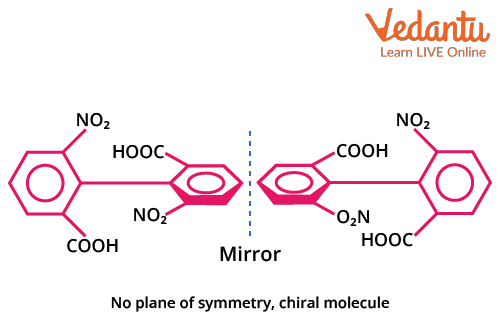
Optical isomerism in biphenyls
Conclusion
Optical isomers are chemically equivalent but still exhibit some different properties that show the complexity and need to understand the three-dimensional structures of chemical compounds. Symmetry elements are tools with the help of which one can understand whether the compound is optically active or not. They are imaginary but provide an understanding of real molecules. Allene, spiro compounds, and biphenyls are some compounds that do not possess a chiral carbon yet show chirality because of their three-dimensional structure and asymmetric characteristics.






FAQs on Optical Isomerism in Allene, Spiro, and Biphenyl for JEE
1. Are optical isomers and geometrical isomers the same?
No. Geometrical isomerism is observed in an alkene molecule with differently substituted groups across the double bond. The 2 isomers are referred to as cis and trans, which is based on the relative position of the groups. The rotation is restricted in alkenes across the double bond, and so both the isomers exhibit different spectral properties. Optical isomers however may or may not have double bonds and have the same spectral properties. They only differ in their ability to rotate plane polarised light and their interactivity with other chiral molecules.
2. What is the difference between enantiomers and racemic mixtures?
Enantiomers are optical isomers with non-superimposable mirror images of each other. They are optically active and relate to each other by having the same chemical formula. Racemic mixtures, also known as racemates, are formed by mixing equimolar amounts of optical isomers or enantiomers of a compound. As long as the amount is equal and the isomers have opposite natures in bending the plane polarised light, the racemic mixture is optically inactive. The effect of both isomers nullifies each other’s activity.


















